Mechanical and Thermal Neutron Absorbing Properties of B4C/Aluminum Alloy Composites Fabricated by Stir Casting and Hot Rolling Process
Abstract
1. Introduction
2. Experimental Procedure
3. Results and Discussion
3.1. Microstructures of B4C/Al6061 Composites Fabricated by Stir Casting and Hot Rolling Process
3.2. Interfacial Analysis of B4C/Al6061 Composites
3.3. Mechanical Properties of B4C/Al6061 Composites
3.4. Neutron Shielding Properties of B4C/Al6061 Composites
4. Conclusions
- The measured volume fractions of B4C reinforcement were 4.82, 10.90, 20.02, 25.56, and 29.01% for 5, 10, 20, 25, and 30% B4C/Al6061 composites, respectively—values similar to the target volume ratios.
- Without AlB2 and Al3BC phases, a continuous Al4C3/(Ti,Cr)B2 layer was generated at the B4C/Al interface in the stir-cast B4C/Al6061 composites.
- The interfacial layer generated during stir casting maintained its own structure after the hot rolling process, indicating strong interfacial bonding strength.
- The tensile strengths of the B4C/Al6061 composites clearly increased to 20 vol.% and stayed above the value for Al6061, even reaching 30 vol.% due to partial lack of an interfacial layer at high vol.% B4C/Al6061 composites.
- The measured neutron shielding values of the composites increased with increasing B4C content. The 30 vol.% B4C/Al6061 composite had a 95.6% thermal neutron shielding ratio at 0.158-cm thickness with 19.7 cm−1 macroscopic cross-section.
Author Contributions
Funding
Institutional Review Board Statement
Informed Consent Statement
Data Availability Statement
Conflicts of Interest
Abbreviations
| AMCs | Aluminum matrix composites |
| NACs | Neutron absorber composites |
| MMCs | Metal matrix composites |
| Volume fraction | % |
| Weight fraction | % |
| Tensile strength | MPa |
| Relative density | % |
| Thickness | cm |
| Thermal neutron shielding rate | % |
| Macroscopic cross-section | cm−1 |
References
- Chen, H.S.; Wang, W.X.; Zhou, Y.L.J.; Nie, H.H.; Wu, Q.C. The design, Microstructure and mechanical properties of B4C/6061Al neutron absorber composites fabricated by SPS. Mater. Des. 2016, 94, 360–367. [Google Scholar] [CrossRef]
- Xu, Z.G.; Jiang, L.T.; Zhang, Q.; Qiao, J.; Gong, D.; Wu, G.H. The design of a novel neutron shielding B4C/Al composite containing Gd. Mater. Des. 2016, 111, 375–381. [Google Scholar] [CrossRef]
- Park, B.; Lee, D.; Jo, I.; Lee, S.B.; Lee, S.K.; Cho, S. Automated quantification of reinforcement dispersion in B4C/Al metal matrix composites. Compos. Pt. B Eng. 2020, 181, 107584.
- Lee, H.; Choi, J.H.; Jo, M.C.; Lee, D.; Shin, S.; Jo, I.; Lee, S.-K.; Lee, S. Effects of SiC particulate size on dynamic compressive properties in 7075-T6 Al-SiCp composites. Mater. Sci. Eng. A 2018, 738, 412–419. [Google Scholar] [CrossRef]
- Pavithra, H.S.; Anantha Prasad, M.G. Study on microstructure and mechanical properties of Al/SiO2/C/ hybrid metal matrix composite, with the influence of chills. Mater. Today Proc. 2018, 5, 6053–6058. [Google Scholar] [CrossRef]
- Tian, H.-S.; Zhao, Q.-L.; Geng, R.; Qiu, F.; Jiang, Q.-C. Improved creep resistance of Al-Cu alloy matrix composite reinforced with bimodal-sized TiCp. Mater. Sci. Eng. A 2018, 713, 190–194. [Google Scholar] [CrossRef]
- Pazhouhanfar, Y.; Eghbali, B. Microstructural characterization and mechanical properties of TiB2 reinforced Al6061 matrix composites produced using stir casting process. Mater. Sci. Eng. A 2018, 710, 172–180. [Google Scholar] [CrossRef]
- Gudla, V.C.; Jensen, F.; Simar, A.; Shabadi, R.; Ambat, R. Friction stir processed Al-TiO2 surface composites: Anodising behavior and optical appearance. Appl. Surf. Sci. 2015, 324, 554–562. [Google Scholar] [CrossRef]
- Tahamtan, S.; Halvaee, A.; Emamy, M.; Zabihi, M.S. Fabrication of Al/A206-Al2O3 nano/micro composite by combining ball milling and stir casting technology. Mater. Des. 2013, 49, 347–359. [Google Scholar] [CrossRef]
- Em Pul, M.; Calin, R.; Gul, F. Investigation of abrasion in Al-MgO metal matrix composites. Mater. Res. Bull. 2014, 60, 634–639. [Google Scholar] [CrossRef]
- Liu, Z.Y.; Kent, D.; Schaffer, G.B. Powder injection moulding of an Al-AlN metal matrix composite. Mater. Sci. Eng. A 2009, 513–514, 352–356. [Google Scholar] [CrossRef]
- Zhang, P.; Li, J.; Wang, W.X.; Tan, X.Y.; Xie, L.; Guo, F.Y. The design, microstructure and mechanical properties of a novel Gd2O3/6061Al neutron shielding composite. Vacuum 2019, 162, 92–100. [Google Scholar] [CrossRef]
- Steinman, A.E.; Corthay, S.; Firestein, K.L.; Kvashnim, D.G.; Kovalskii, A.M.; Matveev, A.T.; Sorokin, P.B.; Golberg, D.V.; Shtansky, D.V. Al-based composites reinforced with AlB2, AlN and BN phases:Experimental and theoretical studies. Mater. Des. 2018, 141, 88–98. [Google Scholar] [CrossRef]
- Raj, R.; Thakur, D.G. Qualitative and quantitative assessment of microstructure in Al-B4C metal matrix composite processed by modified stir casting technique. Arch. Civ. Mech. Eng. 2016, 16, 949–960. [Google Scholar] [CrossRef]
- Jiang, L.T.; Xu, Z.G.; Fei, Y.K.; Zhang, Q.; Qiao, J.; Wu, G.H. The design of novel neutron shielding (Gd+B4C)6061Al composites and its properties after hot rolling. Compos. Pt. B Eng. 2019, 168, 183–194. [Google Scholar] [CrossRef]
- Hidaka, H.; Gauthier-Lafaye, F. Neutron capture effects on SM and Gd isotopes in uraninites. Geochim. Cosmochim. Acta. 2001, 65, 941–949. [Google Scholar] [CrossRef]
- Dubovichenko, S.B.; Burkova, N.A.; Dzhazairov-Kakhramanov, A.V. Influence of low-lying resonances on reaction rates for 10B(n,ɣ)11B capture. Nucl. Phys. A 2019, 992, 121625. [Google Scholar] [CrossRef]
- Naseri, M.; Hassani, A.; Tajally, M. An alternative method for manufacturing Al/B4C/SiC hybrid composite strips by cross accumulative roll bonding (CARB) process. Ceram. Int. 2015, 41, 13461–13469. [Google Scholar] [CrossRef]
- Zhang, L.; Shi, J.; Shen, C.; Zhou, X.; Peng, S.; Long, X. B4C-Al Composites Fabricated by the Powder Metallurgy Process. Appl. Sci. 2017, 7, 1009. [Google Scholar] [CrossRef]
- Tariq, N.H.; Gyansah, L.; Wang, J.Q.; Qiu, X.; Feng, B.; Siddique, M.T.; Siddique, M.T.; Xiong, T.Y. Cold spray additive manufacturing: A viable strategy to fabricate thick B4C/Al composite coating for neutron shielding applications. Surf. Coat. Technol. 2018, 339, 224–236. [Google Scholar] [CrossRef]
- Abenojar, J.; Martinez, M.A.; Velasco, F. Effect of the boron content in the aluminium/boron composite. J. Alloys Compd. 2006, 442, 67. [Google Scholar] [CrossRef]
- Soliman, M.S.; El Rayes, M.M.; Abbas, A.T.; Pimenov, D.Y.; Erdakov, I.N.; Junaedi, H. Effect of tensile strain rate on high-temperature deformation and fracture of rolled Al-15vol% B4C composite. Mater. Sci. Eng. A 2019, 749, 129–136. [Google Scholar] [CrossRef]
- Gudipudi, S.; Nagamuthu, S.; Subbian, K.S.; Chilakalapalli, S.P.R. Enhanced mechanical properties of AA6061-B4C composites, developed by a novel ultra-sonic assisted stir casting. Eng. Sci. Technol. Int. J. 2020, 23, 1233–1243. [Google Scholar] [CrossRef]
- Mungara, S.R.; Manohar, H.S.; Trishul, M.A. Study of mechanical characteristics of stir cast AA7050-B4C metal matrix ceramic composites. Mater. Today Proc. 2020. [CrossRef]
- Ravi, B.; Balu Naik, B.; Udaya Prakash, J. Characterization of aluminium matrix composites (AA6061/B4C) fabricated by stir casting technique. Mater. Today Proc. 2015, 2, 2984–2990. [Google Scholar] [CrossRef]
- Zhang, L.; Shi, G.; Kun, X.; Wu, H.; Li, Q.; Wu, J.; Wang, Z. Phase transformation and mechanical properties of B4C/Al composites. J. Mater. Res. 2020, 9, 2116–2126. [Google Scholar] [CrossRef]
- Lee, D.; Kim, J.; Lee, S.-K.; Kim, Y.; Lee, S.; Cho, S. Experimental and thermodynamic study on interfacial reaction of B4C/Al6061 composites fabricated by stir casting process. J. Alloys Compd. 2021, 859, 157813. [Google Scholar] [CrossRef]
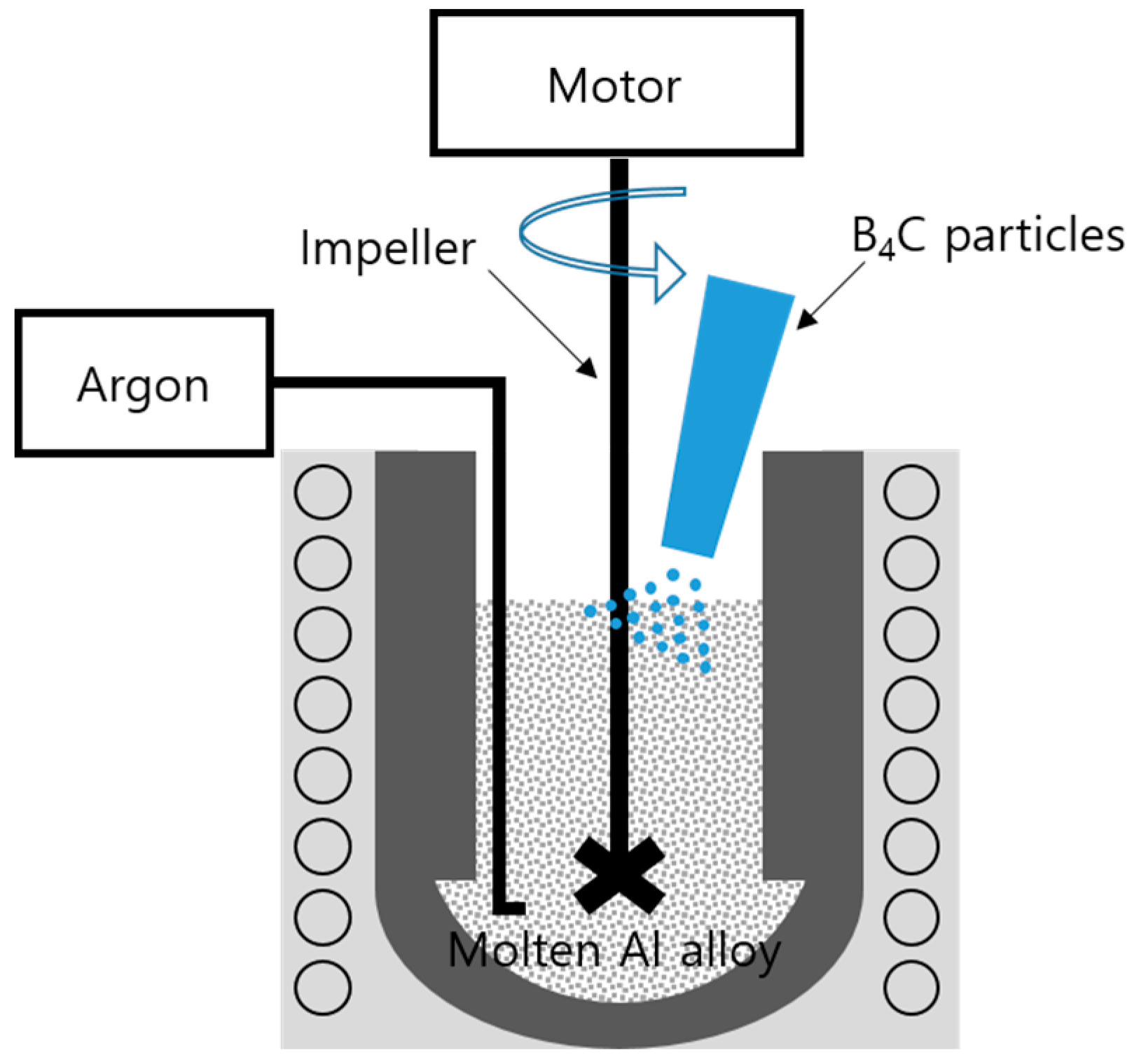
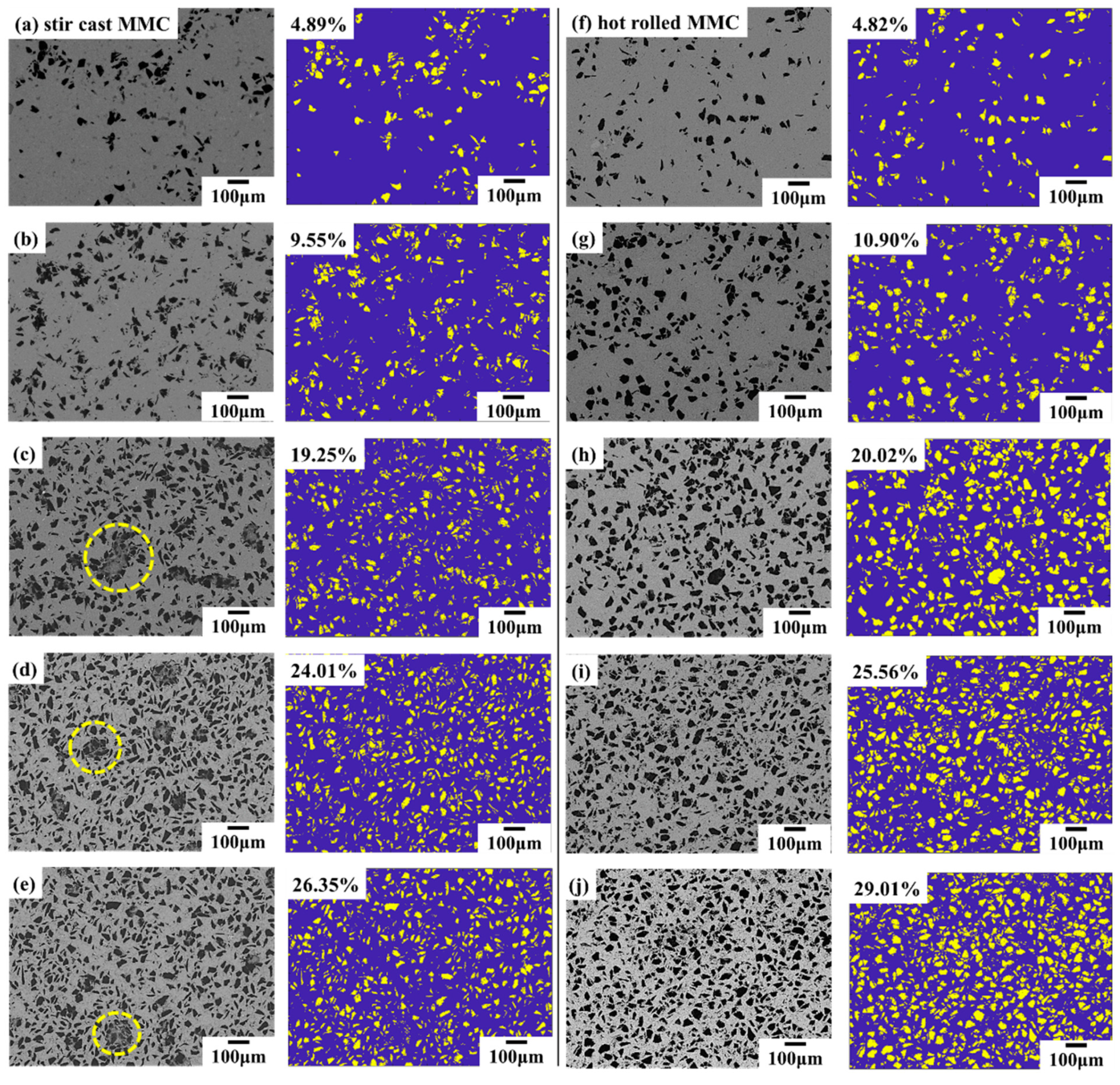
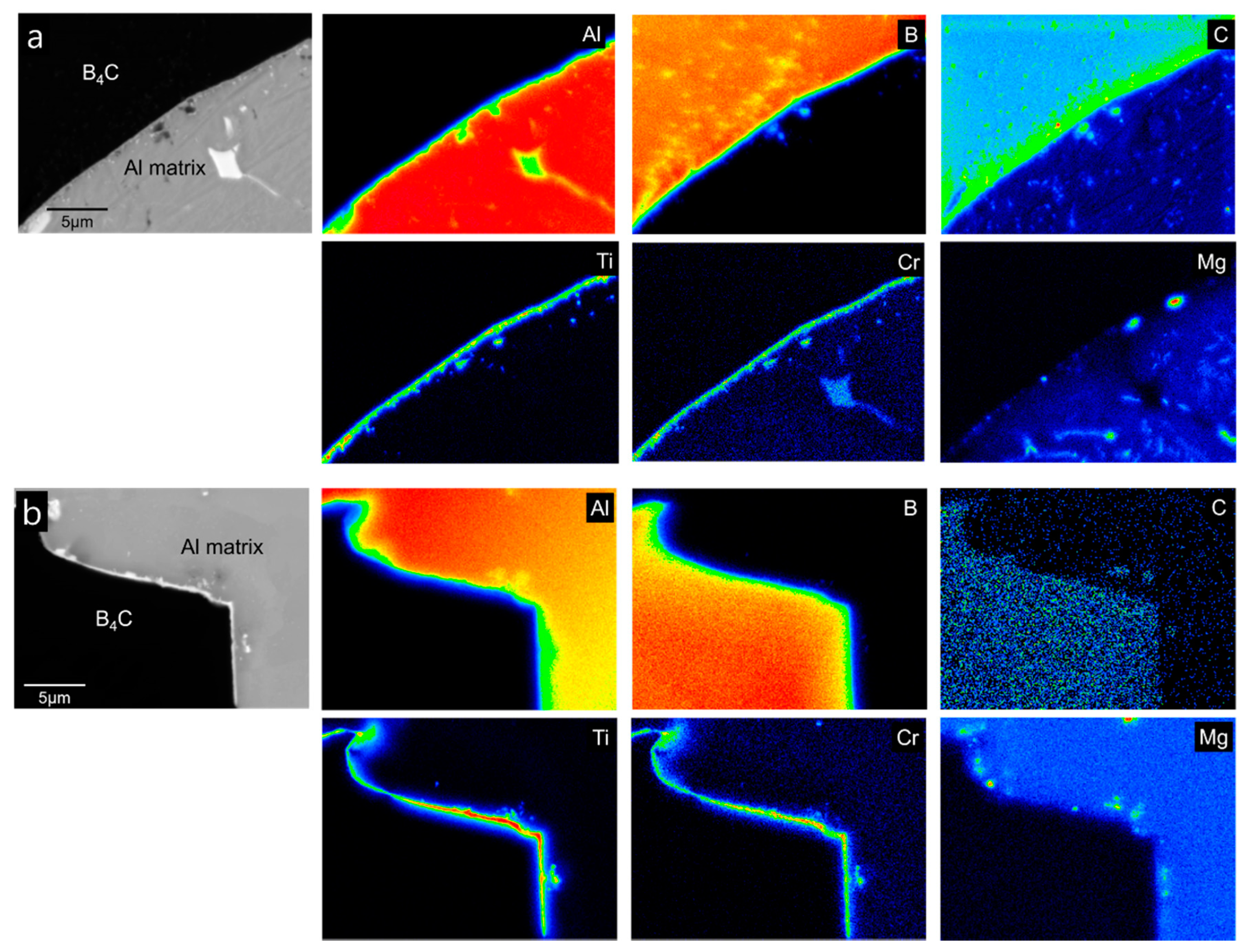
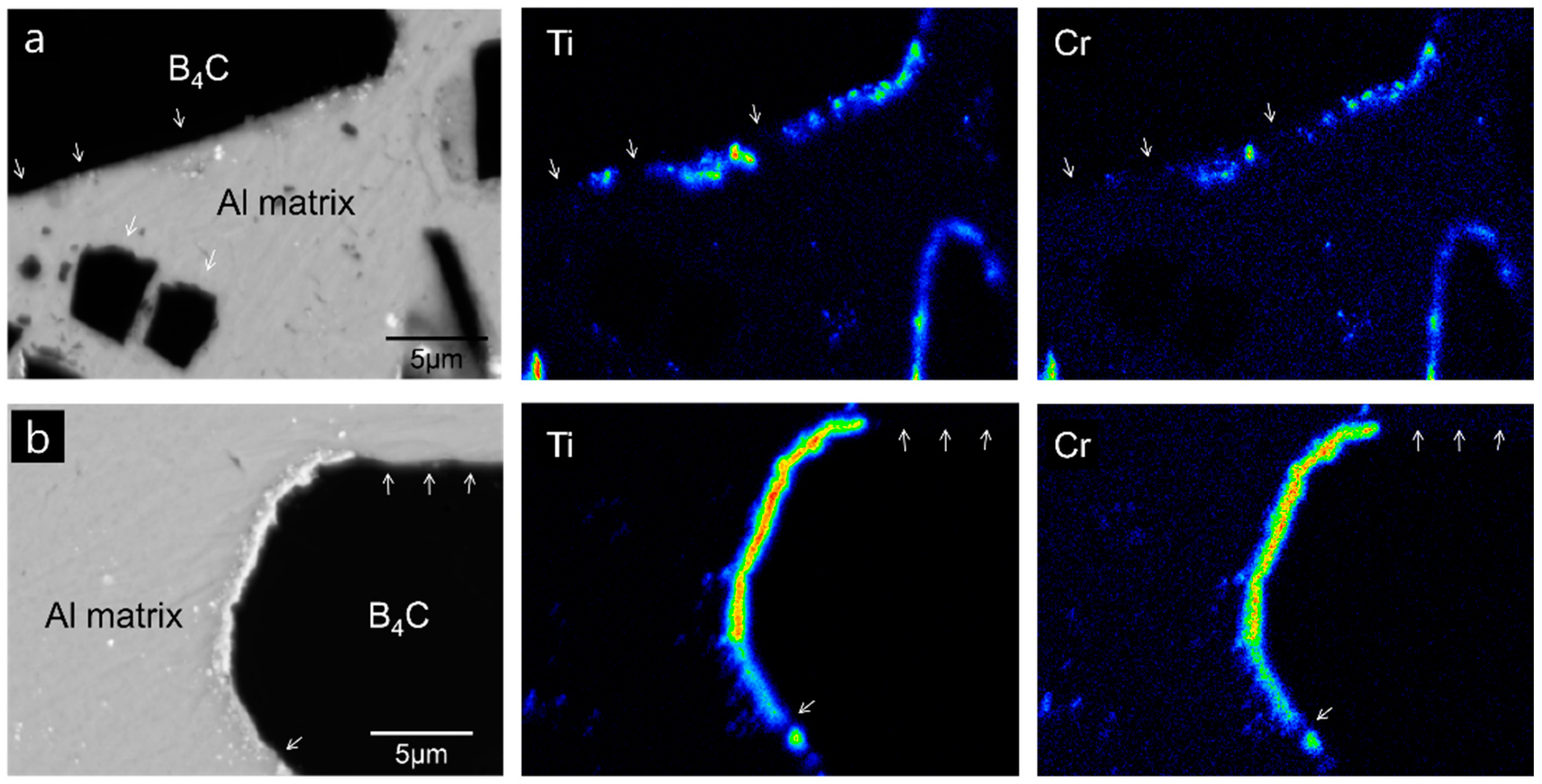

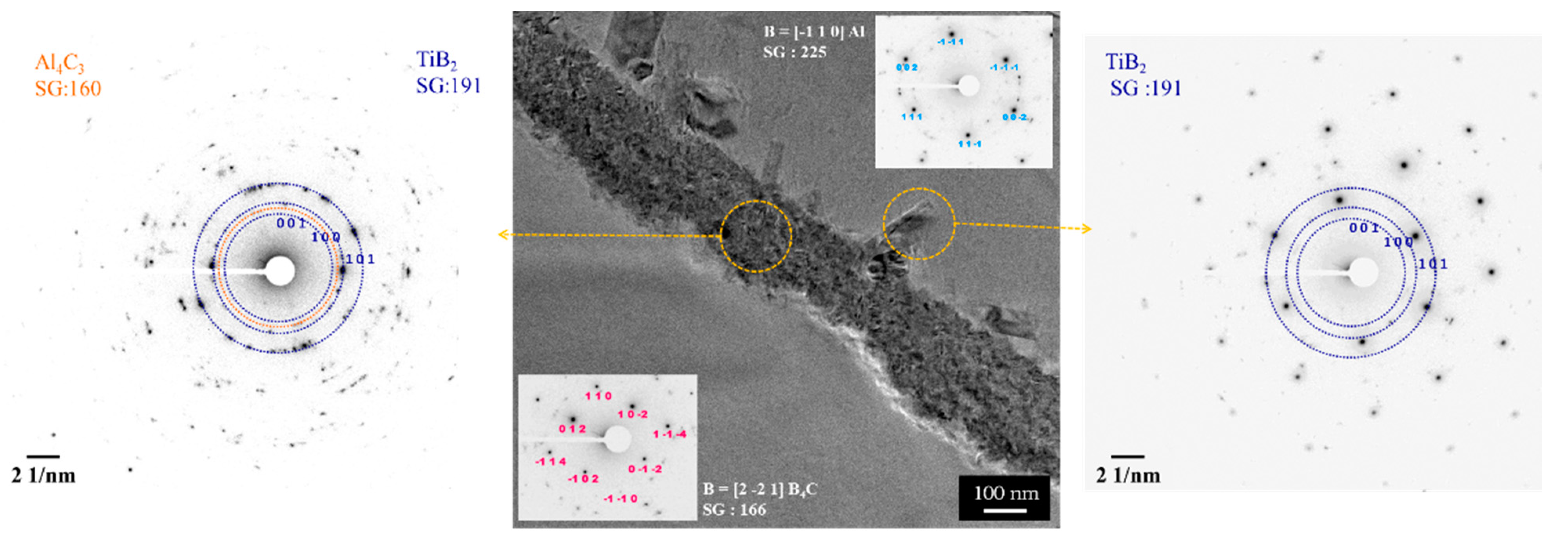

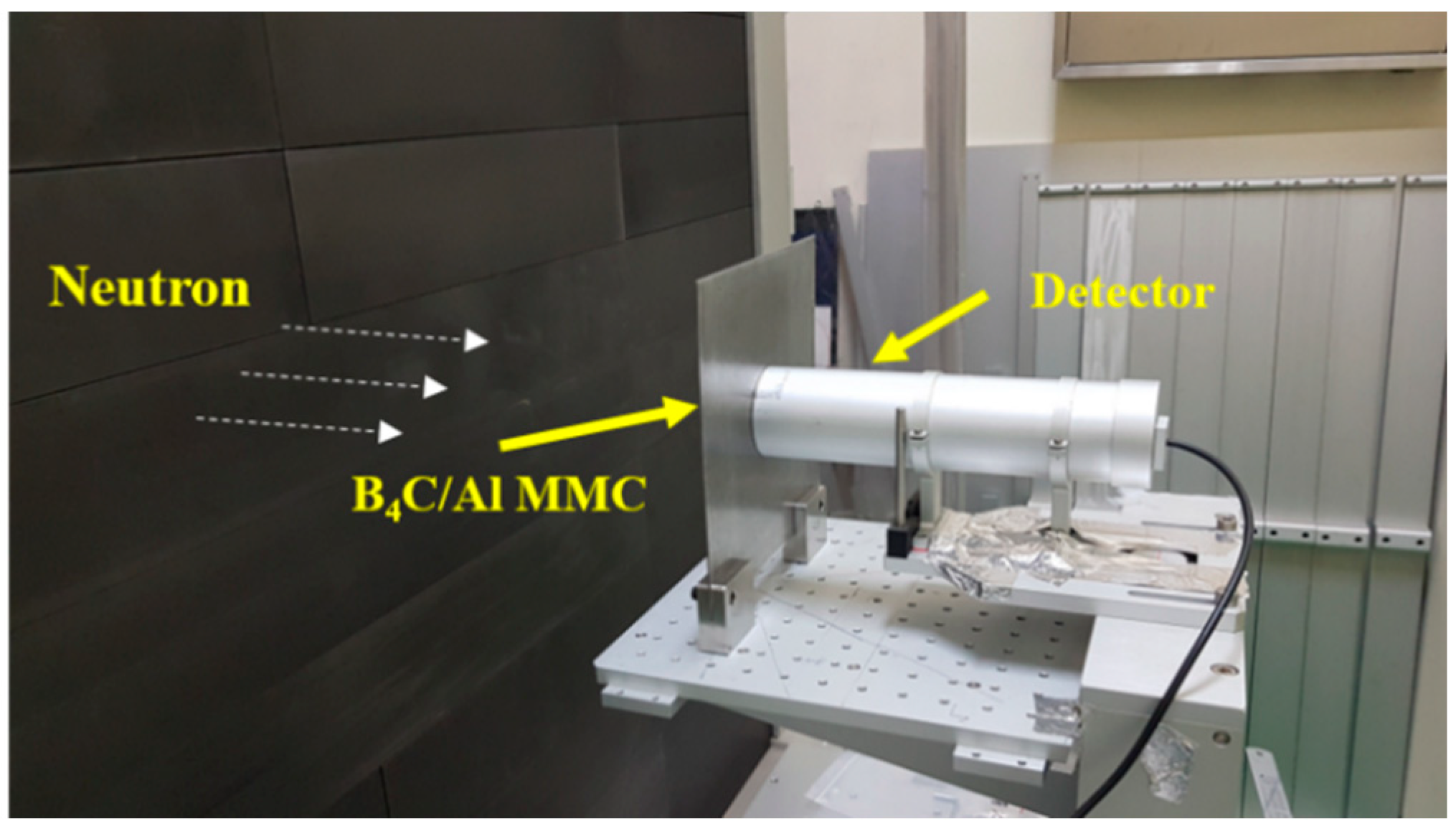
| Si | Fe | Cu | Mn | Mg | Cr | Zn | Ti | Al |
|---|---|---|---|---|---|---|---|---|
| 0.529 | 0.549 | 0.172 | 0.086 | 0.954 | 0.142 | 0.0061 | 0.031 | 97.450 |
| B4C vol.% | Tensile Strength (MPa) | Relative Density (%) | ||
|---|---|---|---|---|
| Stir Casting | Hot Rolled | Stir Casting | Hot Rolled | |
| 0 | 173.5 ± 0.7 | 188.9 ± 0.4 | - | - |
| 5 | 127.8 ± 7.5 | 249.4 ± 10.3 | 96.6 | 99.3 |
| 10 | 123.4 ± 3.7 | 272.5 ± 4.9 | 94.1 | 99.3 |
| 20 | 103.6 ± 2.3 | 289.2 ± 1.7 | 95.1 | 98.9 |
| 25 | 97.1 ± 6.0 | 241.9 ± 1.0 | 92.8 | 99.2 |
| 30 | 102.6 ± 13.9 | 224.5 ± 2.4 | 93.8 | 100.0 |
| B4C vol.% | Thermal Neutron Shielding Rate (%) | Macroscopic Cross-Section (cm−1) | Thickness (cm) |
|---|---|---|---|
| 5 | 50.9 | 4.50 | 0.158 |
| 10 | 75.4 | 8.25 | 0.170 |
| 20 | 90.6 | 13.91 | 0.170 |
| 25 | 94.8 | 18.70 | 0.158 |
| 30 | 95.6 | 19.70 | 0.158 |
Publisher’s Note: MDPI stays neutral with regard to jurisdictional claims in published maps and institutional affiliations. |
© 2021 by the authors. Licensee MDPI, Basel, Switzerland. This article is an open access article distributed under the terms and conditions of the Creative Commons Attribution (CC BY) license (http://creativecommons.org/licenses/by/4.0/).
Share and Cite
Lee, D.; Kim, J.; Park, B.; Jo, I.; Lee, S.-K.; Kim, Y.; Lee, S.-B.; Cho, S. Mechanical and Thermal Neutron Absorbing Properties of B4C/Aluminum Alloy Composites Fabricated by Stir Casting and Hot Rolling Process. Metals 2021, 11, 413. https://doi.org/10.3390/met11030413
Lee D, Kim J, Park B, Jo I, Lee S-K, Kim Y, Lee S-B, Cho S. Mechanical and Thermal Neutron Absorbing Properties of B4C/Aluminum Alloy Composites Fabricated by Stir Casting and Hot Rolling Process. Metals. 2021; 11(3):413. https://doi.org/10.3390/met11030413
Chicago/Turabian StyleLee, Donghyun, Junghwan Kim, Byeongjin Park, Ilguk Jo, Sang-Kwan Lee, Yangdo Kim, Sang-Bok Lee, and Seungchan Cho. 2021. "Mechanical and Thermal Neutron Absorbing Properties of B4C/Aluminum Alloy Composites Fabricated by Stir Casting and Hot Rolling Process" Metals 11, no. 3: 413. https://doi.org/10.3390/met11030413
APA StyleLee, D., Kim, J., Park, B., Jo, I., Lee, S.-K., Kim, Y., Lee, S.-B., & Cho, S. (2021). Mechanical and Thermal Neutron Absorbing Properties of B4C/Aluminum Alloy Composites Fabricated by Stir Casting and Hot Rolling Process. Metals, 11(3), 413. https://doi.org/10.3390/met11030413









